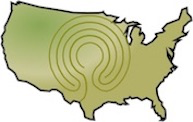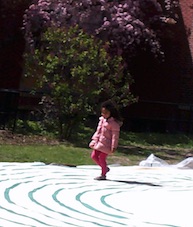
Where are we now and next?
Find out where the labyrinth is.

About the project.
Find out what
inspired the project.

Tune in.
Listen to a recent podcast
interview about the project.

Listen to an audio sample
from our new book.

Books and Resources.
Books, videos, DVDs,
weblinks and more for
finding out about labyrinths.

Keep in touch.
Find out about our progress via our
Facebook page or blog.


WALKING THE LABYRINTH.
About Labyrinths
Labyrinths can be found all over the world, and have a long history. Common patterns etched into the ground, paved in stone, or marked out on cave walls have been discovered in many locations.
Labyrinths have been particularly popular at during different periods in history. Labyrinths feature in many Roman mosaics, while by the 12th century C.E., they had been incorporated into the floors of a number of northern Europe’s great cathedrals.
The design for the labyrinth used for this project is based on a pattern known as the “Baltic style”, mirroring a layout found in hundreds of stone labyrinths around the coast of Scandinavia. These mediaeval constructions were thought to have been used primarily by fisherfolk, who would perform a ceremony to seek protection and ask for a good catch before setting off on their dangerous fishing missions.
Labyrinths are not owned by any one culture or religion. Ancient examples are found in most continents, although their purpose remains a mystery. Labyrinths have certainly been used for ceremonial purposes, as well as serving as gathering places. Most commonly, they have been used for walking (in earlier times, often as part of a pilgrimage, but now, most normally for meditation, reflection, and a simple escape from the busyness and concerns of everyday life).
There are now thought to be around 10,000 labyrinths in the United States alone. Many of these are portable labyrinths, painted onto a canvas mat or some other material, as in the case of the labyrinth that is being used for this project. This idea owes much to the work of Rev. Dr. Lauren Artress, who pioneered the use of a canvas labyrinth at Grace Cathedral in San Francisco in the 1990s. The portability of this innovation became immediately popular, and spawned the creation of hundreds of similar foldaway labyrinths across the US.
Many permanent labyrinth installations have also been created. Clubs, churches, mosques, temples, hospitals, town squares, public parks, prisons, and schools are among the many places that labyrinths can be found.
Today, many people walk labyrinths to meditate, reflect, or detach from the everyday for a short while. Many people report feeling inspired, uplifted, having flashes of inspiration, but most commonly having a sense of peace when walking a labyrinth. Were it to offer nothing else, the labyrinth offers a safe space where you can be at one with yourself, not demanding anything from you other than that you put one foot in front of the other and breathe!
No qualifications or experience are needed to walk a labyrinth; labyrinths are equally relevant for people of faith or who consider themselves to be “spiritual”, and for those who aren’t. The labyrinth invites anyone and everyone to enjoy its embrace and mystery – perhaps you will be among them!
Note: there are many fine books, DVDs, and websites for learning more about the history and uses of labyrinths. Three very good starting points are The Labyrinth Society, Veriditas, and Labyrinthos. The resources page on this website also lists a wide range of books, websites, videos, podcasts, and more, for finding out about labyrinths – and our book (available in English and Spanish) was purposefully written to provide a handy introduction to the history, appeal, and practice of labyrinth walking.
What to expect if you come to a labyrinth walk
An important aim of this project is to give opportunities to people who may never have come across a labyrinth before to enjoy walking one. One beauty of the labyrinth is that no qualification or experience is needed to walk one – just a readiness to take a little time to do so, and to respect the interests of other walkers.
The labyrinth is a single path, toward the centre – there are no dead ends or blind passageways for getting lost. All that’s necessary is to start at the beginning, move at your own pace, stop a while at the center if you wish to, and then quietly leave the labyrinth via the exit path.
As each stopping point on this labyrinth’s journey, usually I (Clive) will start each walk with a brief introduction, before inviting you to come onto the labyrinth and begin your walk whenever you feel ready. Often, individuals may feel that they want to settle themselves before doing this – and a natural spacing out of people coming onto the labyrinth will occur (in hosting, I will suggest not following too closely behind another person when starting your walk). A handout, filling in on aspects of the introduction, will be available for anyone arriving late. A handout offering guidance in Spanish will also be available / Un folleto que ofrezca orientación en español también estará disponible.
During the walk, you may feel inclined to walk at a quicker pace and sometimes slower than others, possibly occasionally wanting to stop. You may need to occasionally sidestep to pass by someone who is walking ahead of you, or others may need to pass by you. The walk is not a race! Take whatever time you need to arrive at the center, and rest there a while if you wish to (sit, stand kneel or whatever feels right). When you are ready, leave the labyrinth by the path opposite the one that you entered the center from. Then, simply return to your place to rest a while longer, and feel free to leave when you wish.
Note, at some venues, I will endeavour to provide coffee and croissants, or some other refreshments, for anyone who wants to join me and other walkers for a brief chat after the walk is finished. I would ask for a small contribution toward the cost of refreshments, if you’re able, and also invite any voluntary contributions toward the costs of hosting the labyrinth, but these are totally voluntary and any contributions are offered discreetly. There is no cost for walking the labyrinth!
While there are no hard and fast rules for walking a labyrinth, I do suggest that the following guidelines are observed:
• If you’re able, please remove boots or shoes before walking the labyrinth, especially if they are muddy. This will help preserve the life of the labyrinth.
• Please switch off mobile phones, and avoid talking while walking and while waiting for others to finish their walk.
• Please enter the labyrinth via the path on the left. The path to the right is the exit path from the centre. This will minimise the need to step past people coming from different directions.
• Hold your hands out, walk at any pace, and do whatever feels right on the labyrinth – but please be mindful of the interests of others. Please note too that I can’t be held responsible for any accident that might occur during a walk, however unlikely that may be. Please note that children under 9 years of age must be supervised.
• Don't run on the labyrinth.
• When the time that we have available is beginning to draw to a close, I will begin to very slowly walk around the edge of the labyrinth. If you are still walking at this time, please start to bring your own walk to a close. We may be restricted in the time that we have available at particular venues.
Service dogs are very welcome on the labyrinth, whether or not they are able to guide their owners along the painted path.
People who need walking sticks, use wheelchairs, or need other aids for walking are as welcome to walk as everyone else. However, motorised buggies are likely to damage the labyrinth, and be distracting for other walkers, therefore regrettably, I ask that these not be used. I will have a finger labyrinth available for anyone who can't physically walk the floor labyrinth. I may also ask that wheelchair wheels are rubbed down before starting your walk (or offer to help with this task if I'm free and able), especially if they are particularly muddy! In practice, all that I ask is that everyone who comes to a walk is respectful toward both the labyrinth itself and toward others.
Note: I may occasionally be supported by co-hosts and other helpers. Other facilitators may host walks from time-to-time.
Outdoor walks
Walks in outdoor venues will continue if there is light rain. In the event of severe bad weather necessitating cancellation, I will advise this via this website, Facebook and blog feeds, and will attempt to rearrange the event if possible (although since the labyrinth is on a journey, this may not always be feasible).
After your walk – let us know your thoughts
After your walk, please talk to me, email me at clive.johnson@labyrintharoundamerica.net, or post / send a message on our Facebook page to let me know about your experience. I'd love to hear from you! (Please note that Facebook posts are subject to checking before being put live, so may not appear online immediately).
Find out more about labyrinths
There are now thought to be more than 10,000 labyrinths in the United States, many being available for public use, or hosted by individuals or groups that meet regularly. Chances are that there may be one in or close to your neighbourhood!
The Labyrinth Locator provides an excellent online search facility for finding labyrinths that may be nearby where you are. Click on the following link to access the Labyrinth Locator.
A growing number of folks have portable labyrinths of their own, which may be available for occasional hire, or alternatively, can be hired along with their owner, who will be experienced in hosting and facilitating elaborate walks. The directory on the following page provides listings of individuals offering these services: hire a labyrinth.
Experienced labyrinth hosts include facilitators trained by Veriditas, an organisation founded by Rev. Dr. Lauren Artress, the creator of the modern labyrinth movement, and dedicated to developing the skills and best practice among labyrinth facilitators. Find out more about facilitators and the training Veriditas provides at: veriditas.org, and use the Veriditas search facility to find a facilitator.
Bringing a labyrinth to your community or for personal use
The Labyrinth Society provides a wealth of information for individuals and groups who may be interested in bringing a labyrinth into their own communities, organisations, or homes. Advice on how to create a labyrinth, or have one made, is also available on The Labyrinth Society's website, including information about the many options available – from marking out a labyrinth with rope or masking tape, to permanent, paved creations. Portable labyrinths – the kind used for this project – are especially popular, and can come in all shapes and sizes.
However, it’s not necessary to have a large garden or hall in order to enjoy the benefits of the labyrinth. Neither is it necessary to physically walk a labyrinth to enjoy the practice. Finger labyrinths – small, laptop, carved labyrinths, whose path (or groove) is traced by a finger – are especially good options for those of us who live in small spaces. Similarly, labyrinth paths may be drawn on paper or painted onto a wall (in the latter case, the labyrinth is “walked” by allowing the eyes to follow the path to the center, and back again).
Labyrinths can be formed using paving stones on a lawn, painted onto carpet tiles that can be temporary fitted together in a jigsaw fashion, or carved out in the sand on a beach while the tide is at low water. There is barely any limit to the materials that might be used to create them, nor the environments in which a labyrinth might be set up. Explore the wide range of ideas on The Labyrinth Society website, and the many other helpful resources that are online, and you’ll quickly see that the only real limitation for creating a labyrinth of your own is your imagination! Books, podcasts, online forums, YouTube videos and other sources of information that might be useful as a starting point for investigating options are listed on our resources page.
